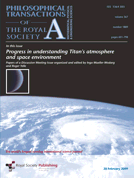
Titan
Titan is Saturn’s largest moon. With a solid body radius of 2575 km, it is larger than our Moon and planet Mercury, but slightly smaller than Mars. It is the second largest moon in our solar system, but the only to possess a significant atmosphere, composed primarily of Nitrogen, the same gas that makes up most of the Earth's atmosphere. In addition, Titan hosts numerous hydrocarbons, the building blocks of life. Free oxygen is not found. Titan's atmosphere is more massive than that on Earth, and the surface pressure is comparable at around 1.5 bar. The average surface temperature is around 95 K. Titan is the only known body in our solar system, apart from Earth, where an active weather system is present with a full cycle of evaporation from the surface, formation of clouds and precipitation (rain). While on Earth it is water that follows this cycle, on Titan it is primarily Methane.




Furthermore, I am member of the Science team of the Ion Neutral Mass Spectrometer (INMS) instrument onboard the Cassini spacecraft. In orbit around Saturn since July 01, 2004, the spacecraft regularly passes by Titan, flying directly through its thermosphere down to around 1000 km altitude, measuring the neutral and ion gas composition in-situ. These measurements will give us the most detailed understanding of Titan’s upper atmosphere yet. The observations are analyzed using the Titan GCM in order to better understand the underlying physical processes.
For more information please visit the Publications page or contact me.
Edited Special Issue:
Titan: Atmosphere and Space Environment, Special issue of Philosophical Transactions of the Royal Society, Feb 2009.
This special issue, based on a 2 day Scientific Discussion Meeting at the Royal Society London contains 13 scientific papers on topics ranging from the origin and evolution of Titan’s atmosphere to its chemistry, dynamics structure from the troposphere to exosphere and magnetic environment. For more information please visit http://rsta.royalsocietypublishing.org/site/issues/titan.xhtml
Special offer: The issue is currently available for purchase at a specially discounted price of £47.50 (normally £58) by contacting Debbie Vaughan at the Royal Society direct (debbie.vaughan@royalsociety.org) or by contacting Portland Customer Services (quoting reference TA 1889), Commerce Way, Colchester CO2 8HP, UK. Tel: +44 (0)1206 796351. Email: sales@portland-services.com
My research focuses on the exploration of the upper regions of Titan’s atmosphere, it’s Thermosphere and Ionosphere. In this region the main atmospheric neutral gases are Nitrogen and Methane. In close collaboration with colleagues at the University of Arizona and Boston University I developed the first General Circulation Model (GCM) of Titan's thermosphere. This has allowed us to examine what drives the winds on Titan, and how the winds transport gases around the globe. The model is used for planning and interpretation of measurements by the Cassini Spacecraft, currently in orbit around Saturn and Titan, and the Huygens probe, which entered Titan's atmosphere on January 14, 2005, and safely landed on its surface.
Temperatures and winds in Titan’s Thermosphere, as modeled by the Titan General Circulation Model
Neutral gas densities in Titan’s upper atmosphere, as measured by the Cassini Ion-Neutral Mass Spectrometer during TA and T5 flybys in Oct 2004 and April 2005, respectively.
